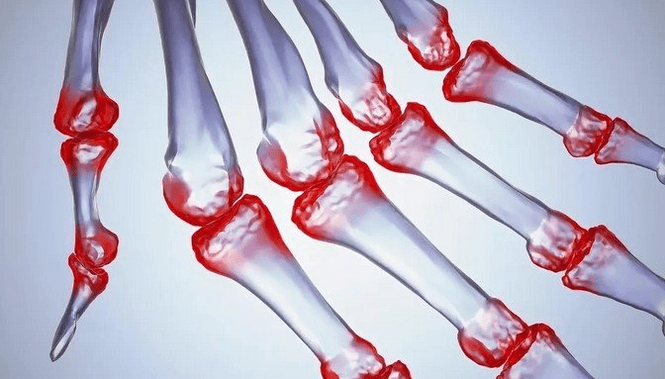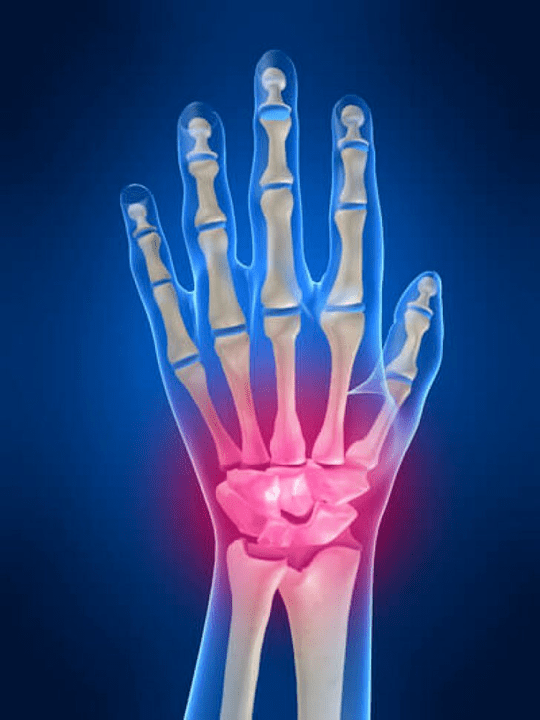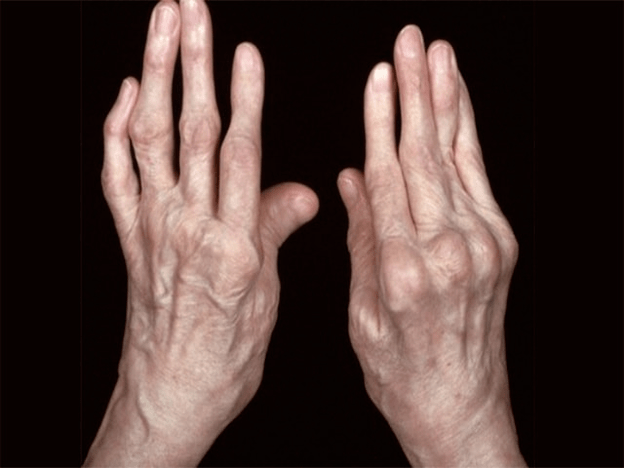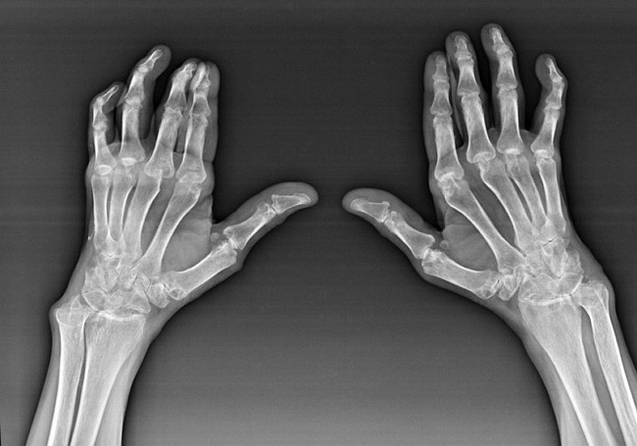
Joint painFingers are an essential sign of any joint pathology in which the structural components of these joints are damaged.First of all, pain in the field of these joints can be associated with various autoimmune diseases (A systemic red chandelier, rheumatoid arthritis, psoriatic arthritis, etc.) in which the immune factors cause damage to their own joint tissues.
The following main reason that may initiatepainIn the finger joints, there may be injuries (bruises, dislocations, bone fractures, ligaments).Pain in these joints can also be caused by degenerative changes occurring in their joint tissues.This can often be observed with osteoarthritis.
Hand joint anatomy
All hand joints are customary to divide into the following groups:
- wrist joint;
- wrist joints;
- carpal joints;
- arrest joints;
- Parliamonal-Phalanx joints;
- Interphalax joints.
Wrist joint
The wrist joint is formed by the bones of the proximal bones (superior) a number of wrists (Triédre, semi-moon, scaphoid bones) and the distal areas of radiation and elbow bones.The elbow bone is not directly connected to the wrist bones, but using distal (Lower) the joint disc.This structure separates the cavity from the wrist joint from the distal cavity (Lower) The joint of the tiles.
Wrist seals
The wrist joints are represented by three types of joints.The first form includes the joints located between the stem bones (Scaphoid, semi-moon, trihedron, pea-shaped) or the lower row (in the shape of a hook, in the head, trapezoidal, bone trapping).These joints are called interchangepene joints.By the second type, the articulation of the mid-dauts so is classified.This seal has a S -shaped shape and is formed due to the connection of the bones of the upper and lower row of the wrist.The third type includes the joint of the pea bone.Thanks to this joint, the trihedrical bone is linked to the pea bone.
Capacity joints
The seals of the carpal panel connect the bones from the wrists and metacarpal bones.These joints are formed by the contact of the proximal ends (land) metacarpal bones and distal sections of carpal bone belonging to the second row.The carpal joints include two main joints.The first is the joint playing carpal in the thumb.It is formed by the connection of the first metacarpal bone with bone trapping.
The second articulation is the articulation of the dear common carpians for the rest of the carpal-prypyna compounds between the second, third, fourth, fifth metacarpal bones and trapezoidal, head bones and, in part, a bone trapping section.The carpal joint of the thumb is separated from the total joint of the carpal potential.Due to which more active are possible, compared to the rest of the carpal paths (which are included in the general joint of the carpale route) which are considered sedentary.The joints of the carpal panel are reinforced by strong joint capsules, as well as by the ligaments (back and palm ligaments).
Interpretain joints
The lateral surfaces of the second, third, fourth and fifth metacarpal bones, when they are contacted by each other, form interprex joints.These joints have distinct joint capsules, which approach the joint capsules of the carpal paths, are linked to them.In addition to the capsules, these joints have a ligament apparatus represented by inter-Sceney metacarpal ligaments, as well as the rear and palm paired ligaments.The interpreter joints are attributed to the sedentary joints of the hand, because the joint surfaces of the bones which form these joints have a flat shape.
Pléen-Phalanx joints
The Parteus-Phalanx joints are compounds between distal (lower) with the ends of metacarpal and proximal bones (superior) Areas of the first phalanges of the fingers of the hand.Each finger of the upper limb has its own metacarponal joint.Thus, there are five metacarpal phalancing articulations of each hand.
Interphalanx joints
The interpophalanx joints are formed by the combination of phalanges close to each of the fingers.Big (First of all) The finger has only one interfalued seal, because this finger has only two phalanxes (proximal and distal).The rest of the fingers of each hand has two interfanals.
The first of them is located between the first (proximal) and the second (average) fingers and called proximal phalanges (superior) Interphalang joint.The second forms the connection between the average (second) And the last (distal) Phalanges from the finger.The second interphalangeal joints are called distal interfanating articulations.Inter-Phalanx joints are reinforced with collateral and palmar ligaments.These joints belong to the block seals, whose movements are only possible around the frontal plane (Fight and fold).

What structures can be ignited in hand joints?
Inflammation is a typical pathological process characteristic of these tissues and organs that have been damaged for any reason.It should be recalled that, in most cases, each disease (For example, drop, rheumatoid arthritis, etc.) or a trauma that damages the joints of the hands to one degree or another, affects not only the joint, but also perioster it (nerves, muscles, tendons, subcutaneous fat, skin) structures.
The following articular structures can become inflamed in the hands of the hands:
- joint cartilage;
- Pressing bone tissue;
- joint capsule;
- Joint ligaments.
The causes of pain in the joints of the hand and the fingers
The main part between the reasons which cause pain in the joints of the hand and the fingers are occupied by mechanical injuries (Fractures, dislocations, bruises, etc.) and systemic autoimmune diseases (Rheumatoid arthritis, systemic lupus erythematosus, psoriasis, etc.).In addition to these causes, pain in hand joints can cause diseases associated with metabolic disorders (For example, drop, osteoarthrosis).

There are the following main causes that cause pain in the hand and fingers joints:
- Hand and fingers bruise;
- Brush bones fracture;
- dislocations of the brush;
- hand ligaments lesion;
- rheumatoid arthritis;
- Kinbek disease;
- reactive arthritis;
- drop;
- psoriatic arthritis;
- synovitis;
- osteoarthrosis;
- Red lupus system.
Brush and fingers bruise
A bruising is one of the types of closed injuries, in which there are damage to soft tissues (muscles, tendons, nerves, skin) And there are no injuries where the main action of the traumatic factor has been directed.Bruising of soft tissues of the hand and fingers are very rarely found in isolation (separately) Locks of the hand and fingers joints.Consequently, with this type of injury, mixed symptoms are found, indicating both damage to hand joints and the lesion of the periarticular (peri-human) fabrics.The bruises of the brush and fingers are generally found by falling on the hand, damage it with a blunt object, with its compression or pinching.
Very often, bruises of the cystic zone cause damage to the main trunks of the median, radial and elbow (which innervate the area of the hand and fingers), which is immediately manifested by the loss of skin sensitivity, and in some cases even the disappearance of the motor functions of the fingers.
The inflammatory edema of joint and peri-human structures develops following the expansion of many vessels that they are blood supply.This edema is one of the reactions of inflammation, which occurs in response to tissue damage during bruises.
A brush bones fracture
Very often, the cause of pain in hand joints can be various fractures of its bones, because these bones are directly written in the formation of joint surfaces.Depending on the anatomical position of the damaged OS, all fractures are divided into three main groups.The first group includes fractures of the wrist bones.The second includes fractures of tubular metacarpal bones.The third group includes bone fractures from the phalanxes of the fingers.
The most common damage places in the carpale zone of the brush are the semi-moon bones and scaphoid.A fracture of these bones occurs during the falls on the brush and is accompanied by pain in the area of the wrist and the joints of the average wrist.Pain syndrome can also be observed in places of anatomical location of these bones.
The most frequent fracture of the ends of metacarpal bones is a fracture of the base of the first metacarpal bone (The one who is attached to the phalanges of the thumb bones).With this injury, edema and pain appear in the area of the base of the first metatarsal bone, as well as in this part of the Carpale joint, which is directly adjacent to it.The thumb with such a fracture is shortened, folded and leads to the palm of your hand.Its movements are limited.
The fractures of the phalanx of the brush are accompanied by deformation, a decrease in the length of the fingers, the loss of their function, their acute pain and its swelling in their inter-Phalanx joints and their peri-human tissues.With phalanges fingers finger with a displacement of bone fragments, palpation (on palpation) You can identify their bulge on the palmar surface of the brush and at the back, on the contrary, a hole or isolation.These fragments are generally mobile, near them, you can often detect subcutaneous bleeding (hematoma).
Dislocation of the brush
Dislocation is a pathological condition in which the areas of the bones which form any articulation go beyond its anatomical limits, which, thus, manifests itself by a complete or partial loss of the function of this joint.In addition to the altered joint function during dislocations, severe pain in the affected joint, swelling and a local increase in temperature are also found.During the dislocations of the brush, the appearance of swelling is explained not only by the presence of inflammation in the damaged peri-human tissues, as well as by the structures of the joint, but also by a protrusion of the emanated bone joint.
The most common types of brush dislocations
| The name of dislocation | The dislocation mechanism | Which seal is amazed? |
| Real dislocation of the brush | The joint surfaces of the wrist bones are moved to the joint surface of the radial bone to the palm or to the back of the hand. |
|
| Perilunar dislocation | The wrist bones and the rest of the brush are offset from the midday bone and radial at the back of the brush. |
|
| Bone dislocation | At the same time, the scaphoid bone displays dislocation in the radiation side in parallel (in the same plan) to bones neighboring the wrist.Sometimes it can move on the palmar side, that is to say to switch to the palm of bone trapping, less often on the same side of the trapezoidal bone. |
|
| Dislocation of the semi-moon | There is a shift in the half-moon towards the palm, so that the space instead of this bone is not occupied.He is gradually occupied by the head of the head, penetrating here from the second row of the wrist bones.This dislocation is a complication of the self-regulation of perilnar dislocation. |
|
| Dislocation of the first metacarpal bone | The articular surface of the base of the first metacarpal bone is offset from the articular surface of bone trapping on the radiation side, at the top (top (proximal) and in the same plane with the wrist bones.Thus, the thumb is pulled a little back and towards the wrist joint. |
|
| Dislocation of fingers | There are finger dislocations in the metacarpophalangeal joints and the inter-phalanx joints.On the first, the joint surface of the proximal phalanx of the fingers (With all the finger) changes compared to the articular surface of metacarpal bones.With the second, there is a displacement between the bones of the phalanxes of the finger itself.Usually there are back and palm dislocations of the phalanxes of the fingers. |
|
Damage ligaments from the hand
The ligament lesion as well as the bruises of the brush are attributed to closed traumatic damage.This pathology is mainly found with an excessive extension of the hand, the fingers in any direction.The main types of brush lesions are their stretching and rupture.With stretching in the damage area, a slight tension and a partial rupture of the fibers of the connective tissue are observed.With the breakdown of ligaments, the whole ligament is divided into two endless ends.
The main types of breaks in brush ligaments are distinguished:
- rupture of the radial collateral ligament of the wrist;
- rupture of the collateral ligament of the wrist elbow;
- rupture of interception ligaments;
- rupture of the lateral ligaments of the metacarpal phalancing joints;
- Rupture of the lateral ligaments of the interphalang joints.
Rheumatoid arthritis
Rheumatoid arthritis is a disease in which the human immune system damages the body's own tissues.In other words, rheumatoid arthritis is an autoimmune pathology.This disease is also systemic, as many tissues are assigned (muscles, joints, vessels, etc.) and the organs (Heart, kidneys, lungs, etc.) in the body.
Despite the fact that rheumatoid arthritis is a systemic disease under it, to a greater extent, the joints suffer, while the lesion of other tissues and organs is in the background.With this disease, almost all types of brush joints can be affected (Brands, carpal paths, metacarpaux-phalanx, inter-plain articulations).The lesion is generally symmetrical (those.The same joints are affected) on both hands, accompanied by swelling, pain in the damaged joints.In the morning, during the lifting of the bed, there is a certain stiffness in the affected joints, which can last about 1 hour, then disappear without trace.
Very often with rheumatic arthritis near the affected joints of the brush (Most often the Piano-Phalanx joints, Inter-Phalanx)) Rheumatoid nodules appear.They are a rounded formation located under the skin.On the brush, these training courses most often occur at the back.On palpation, they are dense, inactive, painless.The number of them can vary.
Kinbek disease
Kinbek's disease is a pathology in which a semi-moon brush carpal bone is affected.The disease is developing following long -term physical overload of the palms of the hands.Usually, it occurs with specialists in construction professions - plaster, mason, carpenters, etc.Excessive physical activity of palm palms most often this bone, as it occupies the central position in the wrist joint.Most often, during the Kinbek disease, the brush with one hand is affected and, as a rule, the main one (The right down hand is damaged, the left down hand is damaged).
Reactive arthritis
Reactive arthritis is a pathology of immunopathological genesis, in which its own immune system attacks various articulations in the body, which is why autoimmune inflammation develops in them.Unlike other autoimmune diseases (For example, rheumatoid arthritis, the systemic lupus erythematosus, in the presence of which an infectious origin is supposed) In reactive arthritis, a clear relationship between infection is traced (and, in particular, intestinal or urogenital) and the development of joint lesions.
In addition, with this pathology, the lymph nodes can increase and the fever appears.When reactive arthritis passes to a chronic form, over time, patients can indicate signs of kidney disease, heart and muscle atrophy, bursitis can occur (Inflammation of periosemant bags), Tendovaginitis (Inflammation of the tendons vagina) and others.
Drop
Gout is a disease based on the development of the accumulation of uric acid in the body and its deposit in the form of salts in the joints.Uralgic acid is the final product of the metabolic of the databases of purine and pyrimidine.They serve as the basis for the construction of DNA and RNA molecules, certain energy formations (Adenosine trifosphate, adenosine monophosphate, etc.) and vitamins.
Pain with gout occurs mainly in the small joints of the lower and upper limbs.In addition, in 50% of all clinical cases, the disease begins with the first joint of the legs.On the hands, as a rule, the interfaced joints of the fingers are affected, less often - the radiating joints.Gout generally damages one or more joints on a single member, sometimes the joints of other members are involved in the inflammatory process.
Psoriatic arthritis
Psoriatic arthritis is a pathology in which various joints are inflamed in the context of psoriasis.The development of psoriasis is based on a violation of the interaction between immune cells and skin cells following what in the body (And especially in the skin) There are autoimmune reactions that cause inflammation.
Synovitis
Synovitis is an inflammation of the synovial shell of the joints, accompanied by damage to its tissues and the accumulation of pathological fluid in the affected joints.Synovitis is not a distinct disease, but rather serves as a complication of other diseases.It can occur with endocrine, allergic, infectious and autoimmune pathologies, brushes, etc.
Osteoarthrosis
Osteoarthritis is a disease in which there is a violation of normal cartilage fabric formation processes in various joints.These processes are violated under the influence of certain external and internal predisposing factors.They can be constant joint injuries, prolonged physical activity (At work, in daily life, during sports), heredity, other joint diseases, etc.
The finger joints are painful with this pathology, because in the periarticular (peri-human) The tissues occur to inflammation, the nerves are affected.A characteristic of osteoarthritis is the link of pain with physical activity.The pain in the joints appears mainly at and / or after a strong physical overload and disappears at rest or after rest.
Red Lupus System
A systemic lupus erythematosus is an autoimmune pathology, in which in the human body, there is a production of an immune system of autoimmune antibodies, attacking various cells and tissue structures.In particular, with it, the production of anti-feed antibodies so called which damage cell nuclei and DNA and RNA are observed.With a red lupus, various tissues and organs are affected - leather, ships, heart, cry, pericardium, kidneys, joints, etc.
The Red System Lupus is constantly associated with other additional signs - weakness, weight loss, fever (Body temperature improvement).However, particular symptoms are of the greatest importance, without which the diagnosis of red lupus is not made.These special signs are photodermatitis (Skin inflammation under the influence of sunlight), discoid rash (The appearance on the skin of the neck, chest of red papers), Lupoid butterfly (The appearance of red spots on the skin near the nose), erosion in the oral cavity, kidney damage (Glomerulonephritis), serrositis (Inflammation of serous membranes) and others.
Diagnosis of causes of pain pain

The hands of pain in hand joints are engaged in the diagnosis and treatment of the causes of pain, mainly a traumatologist and an test doctor.To diagnose such reasons, these doctors mainly use the clinic (Anamnesis collection, external inspection, palpation, etc.), radial (radiography, computed tomography) and the laboratory (General blood test, biochemical blood test, etc.) Research methods.
Depending on the cause of pain in hand joints, all diagnoses can be divided into the following sections:
- Diagnosis of traumatic brush lesions (bruises, dislocations, fractures, ligaments));
- Diagnosis of rheumatoid arthritis;
- Diagnosis of Kinbek's disease;
- diagnosis of reactive arthritis;
- Gout diagnostics;
- diagnosis of psoriatic arthritis;
- Diagnosis of synovitis;
- diagnosis of osteoarthrosis;
- Diagnosis of systemic lupus erythematosus.
Diagnosis of traumatic brushes lesions
When the wounds of the brush, you should consult a traumatologist.The main diagnostic methods that are used in medical practice to identify traumatic brush damage (fractures, dislocations, ligaments, bruises), are an external examination, anamnesis, the methods of searching for radiation (radiography, computed tomography).
The collection of anamnestic data allows the doctor to identify the incidents that have led or could cause a brush injury.The history of anamnesis is also used to clarify the symptoms that disturb the patient.During an external examination on the brush, it is possible to detect swelling, hematomas, its deformation, the limitation of joint mobility.With the help of palpation, the doctor reveals the presence of pain, the violation of the anatomical form of the joint, damage to ligaments.Radiation research methods (radiography, computed tomography) They allow you to confirm the diagnosis, because during their use, mechanical damage to anatomical brush formations are clearly visible.
Treatment of pathologies that cause inflammation of the hand joints

For the treatment of causes of pain in the joints of the hand and the fingers, the doctors, first of all, prescribe a variety of drugs (Anti-inflammatory, pain relievers, anti-Rhevetas drugs, etc.).In some cases, they combine the use of these products with physiotherapeutic procedures.Traumatic brush damage is most often surgically treated or applied to the affected upper limb of gypsum bandage.
To relieve pain and relieve inflammation, the first help may be the use of an external NSAID.The drug selectively blocks the COO-2 and acts directly on the source of pain.It is quickly absorbed thanks to a special texture, leaves no trace of clothes, has a pleasant odor.
According to the pathology which causes inflammation in the hand joints, all the treatment can be divided into the following parts:
- Treatment of traumatic brush injuries (bruises, dislocations, fractures, ligaments));
- treatment of rheumatoid arthritis;
- treatment of Kinbek's disease;
- treatment of reactive arthritis;
- drop treatment;
- treatment of psoriatic arthritis;
- treatment with synovitis;
- treatment of osteoarthritis;
- Treatment of systemic lupus erythematosus.






















